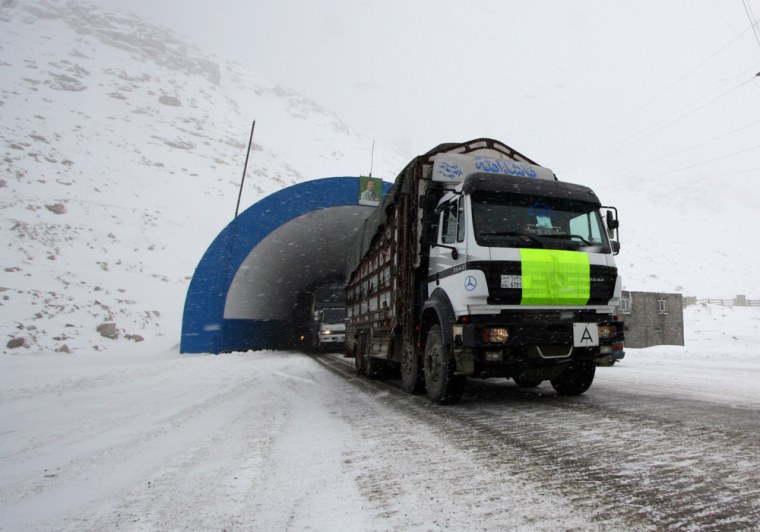SALANG PASS, Afghanistan – The so-called "world's most treacherous tunnel" has received a $19.5 million makeover to help ensure the U.S. military has a guaranteed exit route from landlocked Afghanistan.
Anti-American sentiment and protests generated by drone strikes have prevented trucks moving military hardware out of Afghanistan from crossing Pakistan's main border checkpoint since early this month. The demonstrations have raised questions about whether Pakistani routes can be relied upon as the U.S. prepares to pull out most of its war machinery and troops next year.
Pakistan's previous government also stopped NATO traffic for seven months after a U.S. airstrike killed 24 of its troops in November 2011.

The Salang Tunnel provides an alternative to Pakistan's roads and the port of Karachi by allowing cargo to be instead shipped through neighboring Uzbekistan and Tajikistan.
Located at over 11,000 feet elevation in the Hindu Kush mountains, the 1.6-mile long Salang Tunnel was hailed as an engineering marvel when it was built by the Soviets in the 1960s. But 50 years of neglect turned it into more of an obstacle than a passage.
The U.S. Army Corps of Engineers last year began renovating the tunnel, fixing lighting, improving ventilation and repaving it.
The project was completed late last month and a ceremony handing day-to-day operations back to the Afghans is scheduled within weeks.
"When we started, the tunnel was in really bad shape," project engineer James Fielding told NBC News. "There were potholes every 20 or 30 meters and there were areas where the ruts were so deep that your wheels would get stuck in them."
But even after being upgraded, the Salang Tunnel remains unlike anything most American motorists will have experienced.
Thick, black exhaust limits visibility, cars play chicken with one another on the narrow two-lane road and poor ventilation turns the tunnel into a carbon monoxide death trap for gridlocked motorists. Several people die each year after being overcome by fumes and a 1982 blaze reportedly killed nearly 1,000 Soviet troops.
Col. Michael Price recalled that before the U.S. Army Corps of Engineers completed the refurbishments, drivers could only make out the headlights of oncoming traffic, but otherwise the tunnel was "pretty much pitch black" inside.
Bayan Gul, 47, traveled through Salang more times than he can count as a truck driver.
"The conditions were terrible," he told NBC News. "There would be accidents all the time and there were many times I would have to wait days before I could get through the pass."
"Compared to the past, this is better," said one Afghan truck driver waiting to enter the tunnel. "There are still too many cars, but now there are fewer accidents and that is good."
The tunnel is located on Afghanistan's Highway 1, the main road between the north and south of the country. It is a crucial part of the Northern Distribution Network, a complex web of transit routes through Russia and Central Asia established in 2009.
Utilizing train lines built to supply the Soviets during their war in Afghanistan in the 1980s, the network is key to bringing supplies into Afghanistan. In some cases, goods are transported more than 3,000 miles from the Latvian port of Riga.
However, shipping military equipment through the Salang Tunnel, Central Asia and Russian is slower and more expensive than the more direct route through Pakistan favored by NATO's logisticians.
But the anti-drone protests, which are backed by cricketer-turned-politician Imran Khan, have at times turned violent. Khan's party also released the identity of the CIA's alleged Islamabad station chief.
On Dec. 3, the Pentagon announced it had stopped using Pakistan's Torkham Gate border crossing "to ensure the safety of the drivers contracted to move our equipment."
That route accounts for the vast majority of ground traffic of U.S. military cargo through Pakistan. However, a crossing further south near Chaman and Spin Boldak, where Pakistan's restive Balochistan province borders Afghanistan's violent Kandahar province, remains fully functional.
The United States also flies equipment out of Afghanistan in jets, including munitions and weapons.
Dr. Gareth Price, a senior research fellow at the London-based Chatham House think tank, said that Pakistan's leaders were well aware of the expensive cost to the U.S. of using other routes.
"Pakistan probably thinks it does have a bit of leverage because the U.S. does have so much in Afghanistan and wants to get it out relatively quickly," Price added. "They know that to go through Central Asia is going to cost a lot more money as everyone takes their cut on the way."
Michael O’Hanlon, a senior fellow at the Brookings Institution think tank, said that using alternative supply routes may strengthen relationships with other countries in the region such as Uzbekistan, Tajikistan and Kazakhstan.
"We welcome staying on good terms with the countries to the north. And frankly being able to pay them a few tens of millions of dollars in transit fees is not a bad way to nurture those relationships," he added.
A spokesman for the NATO-led International Security Assistance Force told NBC News that officials expected issues linked to the Pakistani anti-drone protests would have "no long-term impact" on the pullout.
"While we favor shipping cargo via Pakistan because of cost, we have built flexibility and redundancy into our overall system of air, sea and ground routes to transport cargo into and out of Afghanistan," the spokesman added.
Henry Austin reported from London. Wajahat S. Khan reported from Islamabad. Reuters contributed to this report.
Related: